This is an old revision of this page, as edited by RN1970 (talk | contribs) at 12:51, 7 April 2008 (Undid revision 203909050 by 71.138.49.121 (talk) RV:vandalism). The present address (URL) is a permanent link to this revision, which may differ significantly from the current revision.
Revision as of 12:51, 7 April 2008 by RN1970 (talk | contribs) (Undid revision 203909050 by 71.138.49.121 (talk) RV:vandalism)(diff) ← Previous revision | Latest revision (diff) | Newer revision → (diff)
| Cichlids | |
|---|---|

| |
| Common freshwater angelfish, Pterophyllum scalare | |
| Scientific classification | |
| Kingdom: | Animalia |
| Phylum: | Chordata |
| Class: | Actinopterygii |
| Order: | Perciformes |
| Family: | Cichlidae |
| Subfamilies | |
|
Astronotinae | |
Cichlids (Template:PronEng) are fishes from the family Cichlidae in the order Perciformes. The family Cichlidae, a major family of perciform fish, is both large and diverse. There are approximately 1300 scientifically described species, and due to the many species that remain undescribed, it has been estimated that the number will reach more than 1900 species, making it one of the three largest vertebrate families. Cichlids span a wide range of body sizes, from species as small as 2.5 centimetres (1.0 in) in length (e.g. Neolamprologus multifasciatus ) to much larger species approaching 1 metre (3 ft) in length (e.g. Boulengerochromis and Cichla). As a group, cichlids exhibit a similarly wide diversity of body shapes, ranging from strongly laterally compressed species (such as Altolamprologus, Pterophyllum, and Symphysodon) through to species that are cylindrical and highly elongate (such as Julidochromis, Teleogramma, Teleocichla, Crenicichla, and Gobiocichla). Generally, however, cichlids tend to be of medium size, ovate in shape and slightly laterally compressed, and generally very similar to the North American sunfishes in terms of morphology, behaviour, and ecology.
Many cichlids, particularly the tilapias, are important food fishes, while others are valued game fish (eg. Cichla species). Many species, including the angelfish, oscars, and discus, are also highly valued in the aquarium trade. Cichlids are also the family of vertebrates with the largest number of endangered species, most of these found in the haplochromine group. Cichlids are particularly well known for having evolved rapidly into a large number of closely related but morphologically diverse species within large lakes, particularly Tanganyika, Victoria, Malawi, and Edward, . The diversity of cichlids in the African Great Lakes is important for the study of speciation in evolution. Many cichlids that have been accidentally or deliberately released into freshwaters outside of their natural range have become nuisance species, for example tilapia in the southern United States.
Anatomy and appearance

Cichlids are members of a group of perciform fish known as the Labroidei alongside the wrasses Labridae, damselfish Pomacentridae, and surfperches Embiotocidae. This very large grouping shares a single key trait: the fusion of the lower pharyngeal bones into a single tooth-bearing structure. A complex set of muscles allows the upper and lower pharyngeal bones to be used as a second set of jaws for processing food, allowing a division of labour between the "true jaws" (mandibles) and the "pharyngeal jaws". Cichlids in particular have evolved to be very efficient feeders that are able to capture and process a very wide variety of food items and this is assumed to be one reason why they are so diverse (see section on diet below). Cichlids have a great variability in body shape, ranging from compressed and disc-shaped (such as Symphysodon) to elongate and cylindrical (such as Crenicichla ).
The particular features of cichlids that distinguish them from the other Labroidei include:
- A single nostril on each side of the forehead instead of two.
- No bony shelf below the orbit of the eye.
- The lateral line organ is divided into two sections, one on the upper half of the flank and a second along the midline of the flank from about halfway along the body to the base of the tail (except for genera Teleogramma and Gobiocichla).
- A distinctively shaped otolith.
- The small intestine leaves the stomach from its left side, not from its right side as in other Labroidei.
Taxonomy
Kullander (1998) recognises eight subfamilies of cichlids: the Astronotinae, Cichlasomatinae, Cichlinae, Etroplinae, Geophaginae, Heterochromidinae, Pseudocrenilabrinae and Retroculinae. Nelson (2006), however, indicates that cichlid taxonomy is still greatly debated, and despite these attempts, classification of genera cannot yet be accurately given. A comprehensive system of assigning species to monophyletic genera is still lacking, and there is not complete agreement on what genera should be recognized in this family.
As an example of the extant problems in Cichlid taxonomy, Kullander published a phylogeny of the Cichlidae (details of which can be found here) in which the African genus Heterochromis ended up being placed phylogenetically within Neotropical Cichlds, although later papers arrived at different conclusions. Other extant problems (mentioned in the following paragraph) centre upon the identity of the putative common ancestor for the Lake Victoria superflock, and the precise ancestral lineages of the Tanganyikan Cichlids. However, the research is active and intensive (see below for just two of many recent papers), with new papers expected in the immediate future that may resolve some of the outstanding questions.
The paper Multilocus Phylogeny of Cichlid Fishes (Pisces: Perciformes): Evolutionary Comparison of Microsatellite and Single-Copy Nuclear Loci by Streelman, Zardoya, Meyer and Karl (1998) (Mol. Biol. Evol. 15(7):798–808. 1998, paper available as PDF here) provides comparisons between the phylogeny (due to Stiassny, 1991) as determined using morphological characteristics, and two maximum-pasrimony bootstrap consensus trees based upon analyses of two different gene loci, along with majority-rule trees and other similar phylogenetic trees based upon assorted gene locus analyses. There are some extant differences between the assorted trees at the genus level that require resolution, though the consensus from the various nuclear and mitochondrial DNA analyses in this and other papers is that the Cichlidae as a family is monophyletic. Further insights into the attractiveness of Cichlid taxonomy as a fertile area of research is given by the paper The species flocks of East African cichlid fishes: recent advances in molecular phylogenetics and population genetics by Salzburger and Meyer (Naturwissenschaften (2004) 91:277–290, paper available as PDF here), in which the advances made in the analysis of the phylogeny of the Lake Victoria superflock (among other East African Cichlids) is discussed in depth.
One problem that resulted in a major upheaval of Cichlid taxonomy was highlighted by Dr Humphrey Greenwood of the Natural History Museum, London, in a paper in 1977 (cited in TFH magazine, August 1977, with a follow up letter by Dr Greenwood in the November 1977 issue complaining about poor reportage of his work). Dentition (characteristics of tooth shape and arrangement) had been used prior to this date as classifying characteristics, which Greenwood demonstrated was invalid upon phylogenetic grounds because in many Cichlid species, dentition is an environmentally plastic characteristic (tooth shape changes in numerous species with age, due to wear etc), and cannot be relied upon universally across the family as a diagnostic characteristic upon which to base phylogenetic judgements. It is in the light of this that Cichlid taxonomy has undergone major revisions in the 30-plus years since, with the advent of genome sequencing and other technologies adding to the ever-growing body of data resulting in the still-fluid state of Cichlid taxonomy at the genus level.
Range and habitat
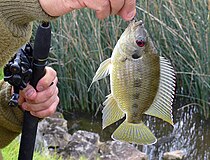
Cichlids are the most species-rich non-Ostariophysan family in freshwaters worldwide. They are mainly freshwater fish that are most diverse in Africa and South America. It is estimated that there will be at least 1600 species in Africa alone when all are discovered and described. Substantial numbers are also found in Central America from Panama to the Mexican portion of North America, with approximately 120 species, as far north as the Rio Grande in southern Texas, and Madagascar has its own distinctive fauna of cichlids phylogenetically only distantly related to those on the African mainland. Endemic cichlids are largely absent in Asia except for four species in the Jordan Valley in the Middle East, one in Iran, and three in India and Sri Lanka. There are three species found in Cuba and Hispaniola. Europe, Australia, Antarctica, and North America north of the Rio Grande River drainage, do not have any native cichlids, although where environmental conditions are suitable, for example in Florida, Mexico (which also has several native species), Japan and northern Australia, feral populations of cichlids have become established as exotics.
Cichlids are largely freshwater fish and are less commonly found in brackish and salt water habitats, though many species will tolerate brackish water for extended periods; Cichlasoma urophthalmus, for example, is equally at home in freshwater marshes and mangrove swamps, and can be found living and breeding in salt water environments such as the mangrove belts around barrier islands. Several species of tilapias (species of Tilapia, Sarotherodon, and Oreochromis) are euryhaline and can disperse along some brackish coastlines between rivers. Only a few cichlids, however, are found primarily in brackish or salt water, most notably Etroplus maculatus, Etroplus suratensis, and Sarotherodon melanotheron.
Diet
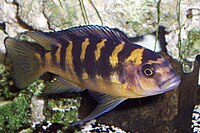
Cichlids are astonishingly diverse in terms of diet. Many are primarily herbivores feeding on algae (e.g. Petrochromis) and plants (e.g. Etroplus suratensis) and small animals, particularly invertebrates, are only a small part of their diet. Some cichlids are detritivores and eat all types of organic material; among these species are the tilapiines of the genera Oreochromis, Sarotherodon, and Tilapia.
Other cichlids are predatory and eat little if any plant matter. These include generalists that catch a variety of small animals including other fishes and insect larvae (e.g. Pterophyllum), as well as variety of specialists. Trematocranus is a specialised snail-eater, while Pungu maclareni feeds on sponges. A number of cichlids feed on other fish, either whole or in part. Crenicichla are stealth-predators that lunge at small fish that pass by their hiding places, while Rhamphochromis are open water pursuit predators that chase down their prey. Paedophagous cichlids such as the Caprichromis species eat other species' eggs or young (in some cases ramming the heads of mouthbrooding species to force them to disgorge their young). Among the more unusual feeding strategies are those of Corematodus spp., Docimodus evelynae, Plecodus, Perissodus and Genyochromis species, which feed on scales and fins of other fishes, a behaviour known as lepidophagy along with the death mimicking behaviour of Nimbochromis and Parachromis species, which lay motionless, luring small fish to their side prior to ambush.
Scientists believe it is this wide adaptability of feeding styles that has helped cichlids to inhabit such a wide range of habitats. It is largely the pharyngeal teeth (teeth in the throat) that allows the cichlids so many 'niche' feeding behaviours, i.e. the jaws may be used to hold or pick food, while the pharyngeal teeth are used to crush what was harvested.
Reproduction

Brood care
All species show some form of parental care for both eggs and larvae, often extended to free-swimming young until they are several weeks or months old. Species of this family have highly organized breeding activities.
Parental care falls into one of four categories:Substrate or open brooders, secretive cave brooders (also known as guarding speleophils), and at least two types of mouthbrooding, ovophile mouthbrooding and larvophile mouthbrooding.
Open or substrate brooding cichlids lay their eggs in the open on rocks, leaves or logs. Examples of open brooding cichlids include Pterophyllum, Symphysodon spp and Anomalochromis thomasi. In general, brooding biparental substrate brooding cichlids usually engage in differing roles with regard to protection and raising of the fry. Most commonly, the male parent patrols the pair's territory and repels intruders, while females more intensively tend the brood, fanning water over the eggs, removing infertile eggs and leading the school of fry while foraging. Despite this, both sexes are able to perform the full range of parenting behaviours. Secretive cave spawning cichlids lay their eggs in caves, crevices, holes or discarded mollusc shells (see also: shell brooding cichlids), frequently attaching the eggs to the roof of the chamber. Examples include Pelvicachromis spp., Archocentrus spp and Apistogramma spp. Communication between free-swimming fry and parents of both open and cave spawning cichlids has been observed for a number of cichlids in captivity and in the wild. Frequently this communication is based on body movements, such as shaking and pelvic fin flicking. In addition, parental substrate brooding cichlids assist in finding food resources for their fry. Parental behaviours such as leaf-turning, and fin-digging have been observed for a number of neotropical cichlid species.
Communal parental care, where multiple monogamous pairs care for a mixed school of young have also been observed for a number of cichlid species including: Amphilophus citrinellus, Etroplus suratensis and Tilapia rendalli.
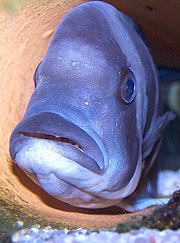
Ovophile mouthbrooders incubate their eggs in their mouths as soon as they are laid, and frequently continue to brood free-swimming fry in their mouths for several weeks. Examples of ovophile mouthbrooding cichlids include many of the cichlids endemic to the Rift Valley lakes (Lake Malawi, Lake Tanganyika and Lake Victoria) in east Africa eg: Maylandia, Pseudotropheus and Tropheus along with some south american cichlids such as Geophagus steindachneri. Larvophile mouthbrooding species lay the eggs in the open, or in a cave and upon hatching take the larvae into the mouth. Examples include some variants of Geophagus altifrons, some Aequidens, Gymnogeophagus and Satanoperca species. Regardless of whether eggs or larvae are subject to mouthbrooding, the vast majority of mouthbrooding cichlids are maternal mouthbrooders, that is the female mouthbroods the young. In the eretmodine cichlids (genera Spathodus, Eretmodus and Tanganicodus), some Sarotherodon species, Chromidotilapia guntheri and some Aequidens species, however, mouthbrooding is practiced by both the male and the female. Paternal mouthbrooding, though rare, is also known to occur in the family eg. Sarotherodon melanotheron. This method is common and appears to have evolved independently in several groups of African cichlids.
Several cichlids, including discus (Symphysodon spp.), some Amphilophus species, Etroplus and Uaru species are noted to feed their young with a skin secretion from mucous glands.
Mating system
Cichlids are either monogamous or polygamous in their mating system. The mating system of any given cichlid species is not consistently associated with the type of brood care the species employs. For example, although most monogamous cichlids are not mouthbrooding cichlids, Chromidotilapia, Gymnogeophagus, Spathodus and Tanganicodus are all monogamous mouthbrooders. In contrast, numerous open or cave spawning cichlids are polygamous, examples include Apistogramma, Lamprologus, Nannacara and Pelvicachromis.
Endangered cichlids
According to the 2007 International Union for Conservation of Nature and Natural Resources red list 156 cichlid species are currently listed as vulnerable, 40 species are listed as endangered, while 69 species are listed as critically endangered. Six species, Haplochromis ishmaeli, Haplochromis lividus, Haplochromis perrieri, Paretroplus menarambo, Platytaeniodus degeni and Yssichromis sp. nov. 'argens' are extinct in the wild, while at least 39 species, most from the genus Haplochromis, have become extinct since the early 1990s.
Lake Victoria
Because of the introduced Nile perch (Lates niloticus) and water hyacinth, deforestation causing siltation of water, and overfishing, many species of Lake Victoria cichlids have been wiped out or drastically reduced in the wild. By around 1980, fisheries of the lake yielded only 1 percent cichlids from all the catch, a drastic decline from 80 percent in the earlier years.

As many as three hundred species or about two-thirds of the endemic cichlids, especially the ones that feed in the open bottom of the lake, became endangered or extinct. Some surviving cichlids, however, have adapted to the new threats by becoming smaller or hybridising with other species. Thankfully, the myriad of satellite lakes surrounding Lake Victoria have not been affected, and harbor an array of similar species.
Cichlids as food and game fish
Although cichlids are mostly small and medium-sized fishes, a substantial number of species are notable as food and game fishes. With few thick rib bones and tasty flesh, artisan fishing of cichlids is not uncommon in Central America and South America, as well as areas surrounding the African rift lakes. The most important food cichlids, however, are the tilapiines of North Africa. Fast growing, tolerant of stocking density, and highly adaptable, tilapiine species have been introduced and farmed extensively in many parts of Asia and are increasingly common in other parts of the world. Production of farmed tilapia, at about 1.5 million tons annually with an estimated value of US$1.8 billion, is about equal to that of salmon and trout. Unlike carnivorous salmon and trout, however, tilapia are mostly omnivorous and can feed on algae or any plant-based food. This reduces the cost of tilapia farming greatly and makes tilapia the ideal "aquatic chickens" of the trade.
In addition to being food fish, many large cichlids also make good game fish. The strong, hard-fighting peacock bass (Cichla species) of South America is one of the most popular sportfish. It was intentionally released in many waters around the world. In Florida, this fish generates millions of hours of fishing and anglers' spendings of more than US$8 million a year. Other cichlids preferred by anglers include the oscar, Mayan cichlid (Cichlasoma urophthalmus), and jaguar guapote (Parachromis managuensis).
Cichlids as aquarium fish

Since 1945, cichlids have become increasingly popular as aquarium fish Cichlids are ideally suited as aquarium fish as many are small to medium-sized, easy to feed with a range of prepared fish foods, breed readily, and practice brood care, in captivity.
The most commonly encountered species in retail aquariums is Pterophyllum scalare from the Amazon River basin in tropical South America, known in the trade as the "angelfish" . Other popular or readily available species of cichlids include the oscar (Astronotus ocellatus), convict cichlid (Archocentrus nigrofasciatus) and discus (Symphysodon spp.).
Species of cichlid can be kept in aquariums with other fish, however, many cichlids are predatory towards smaller fish. Conversely, some cichlids, such as Apistogramma or Julidochromis spp., can be timid in the aquarium. In such cases the use of dither fish is recommended.
Hybrid cichlids and selective breeding

Some cichlids have been found to hybridise with closely related species quite readily, both in the wild and under artificial conditions. This is not particularly unusual, having been observed among other groups of fishes, such as European cyprinids. What is unusual is the extent to which cichlid hybrids have been put to commercial use, in particular as food fish and as aquarium fish. The red strain of tilapia hybrid, for example, is often preferred in aquaculture as they have faster growth rates. Tilapia hybridisation is also used to produce all-male populations to control stock density and prohibit reproduction in ponds.
The most ubiquitous aquarium hybrid is perhaps the blood parrot cichlid which is a cross of several species especially those from genus Amphilophus. With a beak-shaped mouth, an abnormal spine, and an occasionally missing caudal fin (known as the "love heart" parrot cichlid), the fish has caused controversy among aquarium enthusiasts. Some has called blood parrot cichlid "the Frankenstein monster of the fish world." Another notable hybrid, the flowerhorn cichlid, was very popular in some parts of Asia from 2001 until late 2003 and is believed to bring good luck to its owner. The popularity of the flowerhorn cichlid declined in 2004, resulting in many flowerhorn cichlids being released into the rivers and canals of Malaysia and Singapore where they pose a threat to endemic animal communities.
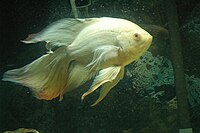
Numerous cichlid species have also been the subject of selective breeding programmes to develop new ornamental strains for the aquarium trade. The most intensive selective breeding programs have involved angelfish and discus and many mutations that effect both colouration and finnage are known. Many other cichlids have been selecively bred for albino, leucistic and xanthistic pigment mutations including oscars, convicts and Pelvicachromis pulcher. Both dominant and recessively inherited pigment mutations have been observed for cichlids. In convict cichlids, for example, a leucistic colouration is recessively inherited, while in Oreochromis niloticus niloticus red colouration is caused by an dominantly inherited mutation.
These efforts at selectively breeding may, however, have unintended consequences. For example, some selectively bred strains of Mikrogeophagus ramirezi have health and fertility problems. Similarly, the inbreeding involved in selective breeding programmes can cause severe physical abnormalies such as the notched phenotype in angelfish.
Genera
As of 2006, there were some 220 genera:
|
|
|
Images of cichlids
- Main gallery: Cichlid images
-
 The oscar (Astronotus ocellatus) is one of the most popular cichlids in the fishkeeping hobby.
The oscar (Astronotus ocellatus) is one of the most popular cichlids in the fishkeeping hobby.
-
 The butterfly peacock bass (Cichla ocellaris) was introduced intentionally in Florida as gamefish.
The butterfly peacock bass (Cichla ocellaris) was introduced intentionally in Florida as gamefish.
-
 The Nile tilapia (Oreochromis niloticus) is farmed extensively as food fish in many parts of the world
The Nile tilapia (Oreochromis niloticus) is farmed extensively as food fish in many parts of the world
-
 The angelfish (Pterophyllum scalare) has long been commercially bred for the aquarium trade.
The angelfish (Pterophyllum scalare) has long been commercially bred for the aquarium trade.
-
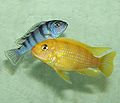 Sexual dimorphism is common in cichlids. Shown here is a male (front) and a female (rear) Maylandia lombardoi
Sexual dimorphism is common in cichlids. Shown here is a male (front) and a female (rear) Maylandia lombardoi
-
 A pair of blue rams (Mikrogeophagus ramirezi), male in front, female behind. Many cichlids form strong pair bonds while breeding.
A pair of blue rams (Mikrogeophagus ramirezi), male in front, female behind. Many cichlids form strong pair bonds while breeding.
-
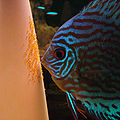 A discus (Symphysodon spp.) is guarding its eggs. Advanced broodcare is one of the defining characteristics of cichlids.
A discus (Symphysodon spp.) is guarding its eggs. Advanced broodcare is one of the defining characteristics of cichlids.
-
 Lake Malawi, Eastern Africa is home to numerous cichild species including this Livingston's cichlid (Nimbochromis livingstonii)
Lake Malawi, Eastern Africa is home to numerous cichild species including this Livingston's cichlid (Nimbochromis livingstonii)
-
 A shell-brooding cichlid of the genus Lamprologus from Lake Tanganyika in East Africa
A shell-brooding cichlid of the genus Lamprologus from Lake Tanganyika in East Africa
-
 The Texas cichlid (Herichthys cyanoguttatus) is the only cichlid native to the USA
The Texas cichlid (Herichthys cyanoguttatus) is the only cichlid native to the USA
-
 Pelvicachromis pulcher is a West African riverine cichlid, and part of the aquarists dwarf cichlid group.
Pelvicachromis pulcher is a West African riverine cichlid, and part of the aquarists dwarf cichlid group.
-
 The flowerhorn cichlid is a man-made hybrid that has recently gained popularity among aquarists, particularly in Asia.
The flowerhorn cichlid is a man-made hybrid that has recently gained popularity among aquarists, particularly in Asia.
- Texas Cichlid (Herichthys cyanoguttatus) Texas Cichlid (Herichthys cyanoguttatus)
- A pair of Egyptian mouthbrooders (Pseudocrenilabrus multicolor). A pair of Egyptian mouthbrooders (Pseudocrenilabrus multicolor).
See also
References
- ^ Froese, Rainer; Pauly, Daniel (eds.). "Family Cichlidae". FishBase. Nov 2006 version.
- ^ Kullander, S.O. (1998). "A phylogeny and classification of the South American Cichlidae (Teleostei: Perciformes)". In L.R. Malabarba, R.E. Reis, R.P. Vari, Z.M. Lucena and C.A.S. Lucena (eds.) (ed.). Phylogeny and classification of neotropical fishes. Porto Alegre: EDIPUCRS. pp. pp. 461-498. ISBN 978-8574300351.
{{cite book}}:|editor=has generic name (help);|pages=has extra text (help)CS1 maint: multiple names: editors list (link) - ^ Loiselle, P.V. (1994). The Cichlid Aquarium. Tetra Press. ISBN 1-56465-146-0.
- Helfman G., Collette B., & Facey D. (1997). The Diversity of Fishes. Blackwell Publishing, Inc. pp. pp. 256-257. ISBN 0-86542-256-7.
{{cite book}}:|pages=has extra text (help)CS1 maint: multiple names: authors list (link) - ^ Chapman, F. A. (1992). "Culture of Hybrid Tilapia: A Reference Profile" (PDF). Circular 1051. University of Florida Institute of Food and Agricultural Sciences.
{{cite journal}}: Cite journal requires|journal=(help) - Reid, G. M. (1990). "Captive breeding for the conservation of cichlid fishes" (fee required). Journal of Fish Biology. 37: pp. 157-166. doi:10.1111/j.1095-8649.1990.tb05031.x.
{{cite journal}}:|pages=has extra text (help); Unknown parameter|month=ignored (help) - Salzburger W., Mack T., Verheyen E., Meyer A. (2005). "Out of Tanganyika: Genesis, explosive speciation, key-innovations and phylogeography of the haplochromine cichlid fishes" (PDF). BMC Evolutionary Biology. 5 (17). doi:10.1186/1471-2148-5-17.
{{cite journal}}: Cite has empty unknown parameter:|1=(help)CS1 maint: multiple names: authors list (link) CS1 maint: unflagged free DOI (link) - Snoeks, J. (ed.) (2004). The cichlid diversity of Lake Malawi/Nyasa/Niassa: identification, distribution and taxonomy. Cichlid Press. ISBN 0-9668255-8-6.
{{cite book}}:|author=has generic name (help) - ^ Kornfield, Irv (2000). "African Cichlid Fishes: Model Systems for Evolutionary Biology". Annual Review of Ecology and Systematics. 31: pp. 163-196. doi:10.1146/annurev.ecolsys.31.1.163.
{{cite journal}}:|pages=has extra text (help); Unknown parameter|coauthors=ignored (|author=suggested) (help); Unknown parameter|month=ignored (help) Cite error: The named reference "Kornfield" was defined multiple times with different content (see the help page). - Gulf States Marine Fisheries Commission. "Fact sheet for Oreochromis mossambicus (Peters, 1852)". Gulf States Marine Fisheries Commission. Retrieved 2006-10-20.
- ^ Stiassny, M.L.J. (1987). "Labroid intrarelationships revisited: morphological complexity, key innovations, and the study of comparative diversity". Bulletin of the Museum of Comparative Zoology, Harvard University. 151: pp. 269-319.
{{cite journal}}:|pages=has extra text (help); Unknown parameter|coauthors=ignored (|author=suggested) (help) - ^ Nelson, Joseph, S. (2006). Fishes of the World. John Wiley & Sons, Inc. ISBN 0471250317.
{{cite book}}: CS1 maint: multiple names: authors list (link) - ^ Koehn, J.D. (2004). "Priority management actions for alien freshwater fish species in Australia" (PDF). New Zealand Journal of Marine and Freshwater Research. 38: pp. 457–472. Retrieved 2007-04-19.
{{cite journal}}:|pages=has extra text (help); Unknown parameter|coauthors=ignored (|author=suggested) (help) - Boruchowitz, D. E. (2006). Guide to Cichlids. T.F.H. Publications. ISBN 0-7938-0584-8.
- ABC Far North Queensland. "Tilapia :: Far North Queensland". Retrieved 2007-04-19.
- Froese, R. and D. Pauly. Editors. "Archocentrus nigrofasciatus, Convict cichlid". FishBase. Retrieved 2007-03-29.
{{cite web}}:|author=has generic name (help) - Yamamoto, M.N. (2000). Hawai'i's native and exotic freshwater animals. Honolulu, Hawaii: Mutual Publishing. pp. p. 200.
{{cite book}}:|pages=has extra text (help); Unknown parameter|coauthors=ignored (|author=suggested) (help) - Page, L.M. (1991). A field guide to freshwater fishes of North America north of Mexico. Boston: Houghton Mifflin Company. pp. p. 432.
{{cite book}}:|pages=has extra text (help); Unknown parameter|coauthors=ignored (|author=suggested) (help) - University of Southern Mississippi/College of Marine Sciences/Gulf Coast Research Laboratory (2005-08-03). "Fact Sheet for Tilapia zilli (Gervais, 1848)". Gulf States Marine Fisheries Commission. Retrieved 2007-02-10.
- Fuller, Pam L. (2002-10-11). "Nonindigenous Fishes of Florida - With a Focus on South Florida". U.S. Department of the Interior, U.S. Geological Survey, Center for Coastal Geology. Retrieved 2007-02-10.
{{cite web}}: Unknown parameter|coauthors=ignored (|author=suggested) (help) - Frank Schäfer (2005). Brackish-Water Fishes. Aqualog. ISBN 3-936027-82-X (English), ISBN 3-936027-81-1 (German).
- ^ Ribbink, A.J. (1982). "Melanochromis crabro sp. nov.: a cichlid fish from Lake Malawi which feeds on ectoparasites and catfish eggs". Netherlands Journal of Zoology. 32 (1): pp. 72-87.
{{cite journal}}:|pages=has extra text (help); Unknown parameter|coauthors=ignored (|author=suggested) (help). Cite error: The named reference "Ribbink" was defined multiple times with different content (see the help page). - Oliver, M.K. (1999-11-18). "Rhamphochromis esox". malawicichlids.com: The Cichlid Fishes of Lake Malawi. Retrieved 2007-04-19.
{{cite web}}: Check date values in:|date=(help) - McKaye, K.R. (1983). "Head ramming behaviour by three paedophagous cichlids in Lake Malawi, Africa". Animal Behaviour. 31: pp. 206-221.
{{cite journal}}:|pages=has extra text (help); Unknown parameter|coauthors=ignored (|author=suggested) (help) - Wilhelm, W. (1980). "The disputed feeding behavior of a paedophagous haplochromine cichlid (Pisces) observed and discussed". Behaviour. 74: pp. 310-323.
{{cite journal}}:|pages=has extra text (help) - Konings, A. (2007). "Paedophagy in Malawi cichlids". Cichlid News. 16: 28–32.
- Trewavas, E. (1947). "An example of "mimicry" in fishes". Nature. 160: 120.
- Eccles, D.H. (1976). "A taxonomic study of the genus Docimodus Boulenger (Pisces, Cichlidae) a group of fishes with unusual feeding habits from Lake Malawi". Zoological Journal of the Linnean Society. 58: 165–172.
{{cite journal}}: Unknown parameter|coauthors=ignored (|author=suggested) (help) - Nshombo, M. (1991). "Occasional egg-eating by the scale-eater Plecodus straeleni (Cichlidae) of Lake Tanganyika". Environmental Biology of Fishes. 31: 207–212.
- Tobler, M. (2005). "Feigning death in the Central American cichlid Parachromis friedrichsthalii". Journal of Fish Biology. 66: 877.
- McKaye, K.R. (1981). "Field observation on death feigning: a unique hunting behavior by the predatory cichlid, Haplochromis livingstoni, of Lake Malawi". Environmental Biology of Fishes. 6: 361–365.
- ^ Riehl, Rüdiger. Editor. (1996. 5th Edn.). Aquarium Atlas. Germany: Tetra Press. ISBN 3-88244-050-3.
{{cite book}}:|first=has generic name (help); Check date values in:|year=(help); Unknown parameter|coauthors=ignored (|author=suggested) (help)CS1 maint: year (link) - Balon, E.K. (1975). "Reproductive guilds of fishes: a proposal. and definition". Journal of the Fisheries Research Board of Canada. 32: 821–864.
- ^ Keenleyside, M.H.A. (1991). "Parental Care". Cichlid Fishes: behaviour, ecology and evolution. London: Chapman and Hall. pp. pp. 191-208. ISBN 0412322005.
{{cite book}}:|pages=has extra text (help) Cite error: The named reference "Keenleyside" was defined multiple times with different content (see the help page). - McKaye, K.R. (1977). "Communal Care and Kidnapping of Young by Parental Cichlids". Evolution. 31: 674–681. doi:10.2307/2407533.
{{cite journal}}: Unknown parameter|coauthors=ignored (|author=suggested) (help) - Ward, J.A. (1977). "Ethology and ecology of cichlid fishes of the genus Etroplus in Sri Lanka: preliminary findings". Environmental Biology of Fishes. 2: 137–145. doi:10.1007/BF00005369.
{{cite journal}}: Unknown parameter|coauthors=ignored (|author=suggested) (help) - Ribbink, A.J. (1981). "Nest-building and communal care of young by Tilapia rendalli dumeril (pisces, cichlidae) in Lake Malawi". Environmental Biology of Fishes. 6: 219–222. doi:10.1007/BF00002787.
{{cite journal}}: Unknown parameter|coauthors=ignored (|author=suggested) (help) - Coleman, R. (1999). "Mysterious mouthbrooders". Cichlid News: 32–33.
{{cite journal}}: Unknown parameter|month=ignored (help) - Kishida, M. (2000). "Paternal Mouthbrooding in the Black-Chinned Tilapia, Sarotherodon melanotheron (Pisces: Cichlidae): Changes in Gonadal Steroids and Potential for Vitellogenin Transfer to Larvae". Hormones and Behavior. 37: 40–48.
{{cite journal}}: Unknown parameter|coauthors=ignored (|author=suggested) (help) - Martin, E. (1997). "Alternative male mating acttics in a cichlid, Pelvicachromis pulcher: a comparison of reproductive effort and success". Behavioral Ecology and Sociobiology. 41: 311–319.
{{cite journal}}: Unknown parameter|coauthors=ignored (|author=suggested) (help) - IUCN 2006. 2006 IUCN Red List of Threatened Species. <www.iucnredlist.org>. Downloaded on 20 April 2007 List of recently extinct Cichlidae
- ^ Barlow, G. W. (2000). The Cichlid Fishes. Cambridge, MA: Perseus Publishing. ISBN 0-7382-0376-9.
- Kaufman L (1996) Haplochromis latifasciata. In: IUCN 2006. 2006 IUCN Red List of Threatened Species.
- De Silva, S.S; Subasinghe, R.P.; Bartley, D.M.; Lowther, A. :Tilapias as Alien Aquatics in Asia and the Pacific: A Review. FAO Fisheries Technical Paper. No. 453, 2004.
- ^ Florida Fish and Wildlife Conservation Commission. "Fact Exotic Freshwater Fishes". Retrieved 2007-3-18.
{{cite web}}: Check date values in:|accessdate=(help) - Sands D (1994) A fishkeepers guide to Central American cichlids. Tetra Press. Belgium pg 59-60.
- Mills D (1993) Aquarium Fish Harper Collins ISBN 0-7322-5012-9
- Konings A (1997) Back to nature guide to Malawi Cichlids Druckhaus Beltz, Germany. p. 13-23
- Leibel WS (1993) A fishkeepers guide to South American cichlids. Tetra Press. Belgium pg 12-14.
- Smith, P. F., Konings, A., and Kornfield I.: Hybrid origin of a cichlid population in Lake Malawi: implications for genetic variation and species diversity. Molecular Ecology 12, pp 2497–2504, 2003
- Wood, A. B., and Jordan, D. R.: Fertility of roach × bream hybrids, Rutilus rutilus (L.) × Abramis brama (L.), and their identification. Journal of Fish Biology 30, pp 249-261, 1987
- Matt Clarke. "Frequently asked questions on Parrot cichlids". Practical Fishkeeping. Retrieved 2006-10-20.
- "It's The Frankenstein Monster Of The Fish World: The Blood Parrot!". AquaFriend.com. 2002-10-27. Retrieved 2006-12-5.
{{cite web}}: Check date values in:|accessdate=and|date=(help) - Arnold W (2003) Singapore's 'lucky' pet Luohan can outnumber people in homes. International Herald Tribune. July 1.
- Crayfish the latest fad among pet lovers New Straits Times (Malaysia) (2004) 3rd September
- Flower Horn: Joy in homes, a pest in rivers. New Straits Times (Malaysia) (2004) 14th July.
- Norton J (1982) Angelfish genetics Freshwater And Marine Aquarium magazine 5:(4)
- Koh TL, Khoo G, Fan LQ, Phang VPE (1999) Genetic diversity among wild forms and cultivated varieties of Discus (Symphysodon spp.) as revealed by Random Amplified Polymorphic DNA (RAPD) fingerprinting Aquaculture 173:485-497.
- Itzkovich J, Rothbard S, Hulata G (1981) Inheritance of pink body colouration in cichlasoma nigrofasciatum Günther (Pisces, Cichlidae). Genetica 55: 15-16.
- McAndrew CJ, Roubal FR, Roberts RJ, Bullock AM, McEwan IM (1988) The genetics and history of red, blond, and associated color variants in Oreochromis niloticus Genetica 76:172.
- Linke H, Staeck L (1994) American cichlids I: Dwarf Cichlids. A handbook for their identification, care and breeding. Tetra Press. Germany. ISBN 1-56465-168-1
- Norton J (1994) Notched - An Angelfish Deformity Freshwater And Marine Aquarium magazine 17:(3)
Further reading
- Barlow, G. W. (2000). The Cichlid fishes. Cambridge MA: Perseus Publishing.
- "Cichlidae". Integrated Taxonomic Information System.: National Museum of Natural History, Washington, D.C., 2004-05-11).
External links
- Lost African Lake Spawned Fish Diversity "Beyond Belief" Discussing the biodiversity of cichlids.
- FishBase.org The most current listing of cichlid taxonomy
- The Cichlid Fishes of Lake Malawi by Dr. Michael Oliver.
- An incomplete listing of cichlid genera and species, with phylogenetic context
- Cichlid-forum.com The largest and most visited cichlid site on the web.
- Cichlid Room Companion by Juan Miguel Artigas Azas.
- American Cichlid Association National American organization dedicated to increasing the knowledge and enjoyment of cichlid fish keeping.
- British Cichlid Association National British organization aimed at promoting the conservation and aquarium study of cichlids.